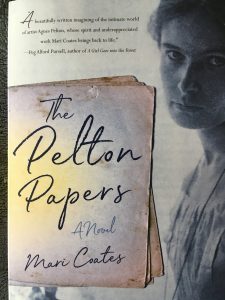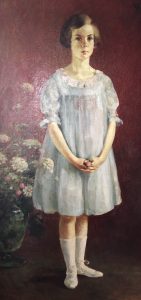Today I’m pleased to introduce you to author Mari Coates whose novel, The Pelton Papers, offers a deeply moving look at Agnes Pelton’s life and artwork, which is currently garnering significant interest with a new show that lands at The Whitney near pub date. Enjoy!
About the Author
Mari Coates lives in San Francisco, where she was an arts writer and theater critic before becoming a senior editor at the University of California Press. She graduated from Connecticut College and holds an MFA from the Warren Wilson Program for Writers. Her stories have been published in literary journals, and she is grateful for residencies at I-Park, Ragdale, and Hypatia-in-the-Woods, which allowed her to develop and complete The Pelton Papers. This is her first novel.

About the Book
It is 1961 and the artist Agnes Pelton, nearly eighty, is close to death. Surrounded by a few of her cherished paintings and the boxes that contain her memorabilia—her papers—she pours out the story of her life. Including a family scandal that happened before she was born—the famous Beecher-Tilton affair, which in the 1870s erupted into an adultery trial. The particulars: Agnes’s grandmother, Elizabeth Tilton, a shy and modest woman, confessed to her husband Theodore that she and Henry Ward Beecher had had an affair. Theodore sued Beecher. At the resulting trial, Elizabeth could not bring herself to publicly admit what she had privately confessed and denied the intimacy. The Tilton family was destroyed while Beecher claimed exoneration. Agnes’s mother Florence, the eldest Tilton daughter and a talented musician, was sent to Europe to get away from it. It was there that she met and married Agnes’s father, William Pelton, and where Agnes is born in 1881.
When the Peltons return to the U.S. in 1888, they move into Elizabeth’s Brooklyn home. No visitors are welcomed to this darkly draped house, and no newspapers are permitted. Florence opens the Pelton School of Music to support them all, but family tragedy continues when William takes his own life in 1890.
As a child Agnes suffers from constant illness and intense shyness but finds her escape at Pratt Institute. She joins a class taught by Arthur Wesley Dow, the modernist pioneer who would transform the way art is taught in America. Agnes embraces his vision and embarks on a lifelong quest for her own style of abstract art.
Success comes early with her inclusion in the Armory Show of 1913. All seems in place for it to continue: she is befriended by Mabel Dodge and mentored by another Manhattan socialite, Alice Brisbane Thursby, with whom she falls into secret and unrequited love. She travels to Italy, New Mexico, Hawaii, and California, all the while developing her spiritual practice and artistic vision. She suffers defeats and heartbreak, and in 1932 arrives in the slightly shabby desert town of Cathedral City, California, near Palm Springs. Here she settles into a contemplative life, painting the vivid abstracts that are her joy and her reason for being. As she struggles to support herself and remain true to her spiritual muse, she confronts failure and finds a way to affirm her own persistence.
How I Got Here

After nearly twenty years of researching and writing about Agnes Pelton—the largely unknown early modernist painter who is being discovered again in a show at the Whitney—my hoped for and struggled with novel-in-progress is a book. It’s 319 pages long. I can hold it in my hands, feel its weight, and marvel at it. What, friends have asked, inspired me? Many things, I reply sagely, scrambling to locate one or two examples. “I grew up with Agnes,” I begin, and it’s true: my grandparents were close friends of hers. They commissioned their own portraits and their children’s, my mother at ten and my uncle at six.
We also had a gorgeous view of Agnes’s Long Island windmill studio and a pair of desert scenes painted after she moved to California.
 We cherished these works, of course, but I got the shock of my life when the first ever Pelton retrospective magically appeared in nearby Oakland, and I discovered that she had painted over one hundred spectacular abstracts, all bursting with color and meaning. That transporting 1996 show suggested an entirely different person from the modest little old lady whose photograph I’d seen.
We cherished these works, of course, but I got the shock of my life when the first ever Pelton retrospective magically appeared in nearby Oakland, and I discovered that she had painted over one hundred spectacular abstracts, all bursting with color and meaning. That transporting 1996 show suggested an entirely different person from the modest little old lady whose photograph I’d seen.
As a writer I rarely create characters from my imagination. My fiction is based on people I’ve seen or known and want to understand better. My MFA thesis was a group of linked stories based on my nuclear family. A cliché to be sure, but I found it healing and expanding to see my parents as people with lives and thoughts and pain of their own. Those stories remain unpublished for the most part but writing them allowed me to turn to other people and other subjects.
I am drawn to the historical. In the 1980s I learned that my grandfather, who died long before I was born, had taken beautiful family photographs that are now part of the New-York Historical Society’s library. Also held there are transcribed folios of letters he’d written, and scrapbooks of clipped letters to the editor of the New York Sun. He was an amateur historian and genealogist, tracing his family roots in New York City back to the 1670s and one André Canon, a Frenchman by way of the Netherlands. I was still a New Yorker at the time and began to sift through these electrifying materials. I found a kindred spirit, an artist with the camera, which was a rarity in the 1890s-1900s. Like Agnes, his fragile health often took him out of the mainstream and into a place of contemplation. He too enjoyed imagining the lives of others and tagged his photographs with captions, noting, for instance, the “artistic temperament” of a property owner in his New York City neighborhood. I was inspired by his inquiring mind and the joy evident in his photographs—“Look over there! What beauty!” Really, though, it was the startling fact of his own life. There he was for me, a living, breathing, highly articulate person who, I felt, would welcome my intrusion into his life and thoughts.
So, I began a novel, or that was the idea. It would center on my grandfather and his writings, which over and over were providing inspiration. While reading through a series of letters that he sent home to Brooklyn in 1906 from southern California, where he was convalescing (a common “treatment” for ill health then), I found a reference to his friend Agnes Pelton and decided to bring her into the novel: another artist of fragile constitution, raised as he was in the very conservative Protestant sect called Plymouth Brethren. I was interested in people with clear religious yearnings who also embraced artistic ambitions.
But once I saw the real Pelton’s abstracts and the startling palettes she used, the landscape of my imagination was dramatically redrawn and flooded in brilliant color. It made me dizzy, tipped me over a bit, upended my world in the best possible way: I wasn’t in Kansas anymore.


 Jill-Elizabeth LinkedIn
Jill-Elizabeth LinkedIn



Leave a Reply